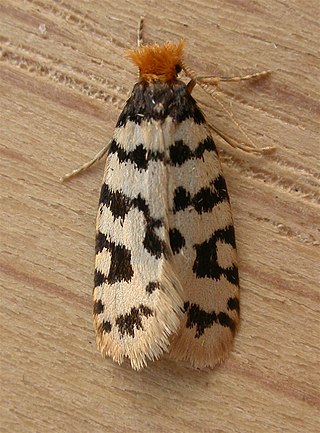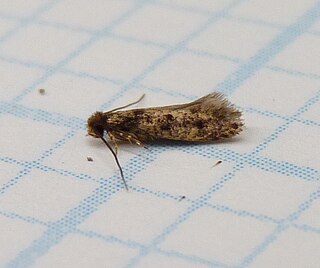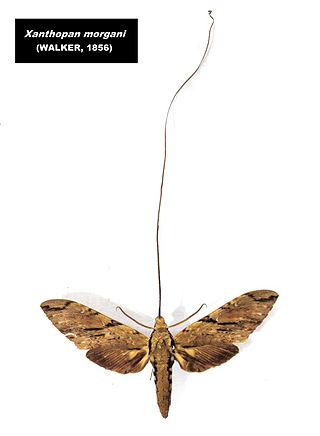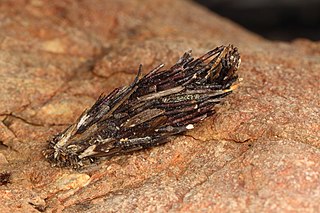
The Psychidae are a family of the Lepidoptera. The bagworm family is fairly small, with about 1,350 species described. Bagworm species are found globally, with some, such as the snailcase bagworm, in modern times settling continents where they are not native.
Fangalabola is a species of bagworm moth native to Madagascar.

Megalyroidea is a small hymenopteran superfamily of wasps that includes a single family, Megalyridae, with eight extant genera and 49 described species. Modern megalyrids are found primarily in the southern hemisphere, though fossils have only been found in the northern hemisphere. The most abundant and species-rich megalyrid fauna is in Australia. Another peak of diversity appears to be in the relict forests of Madagascar, but most of these species are still undescribed.

Galacticidae is a recently recognised and enigmatic family of insects in the lepidopteran order. These moderate sized moths are 8–17 mm in wingspan and have previously been embedded within several lepidopteran superfamilies, but Galacticidae is currently placed in its own superfamily at the base of the natural group Apoditrysia.

Phereoeca uterella, known by the vernacular names plaster bagworm and household casebearer, is a moth species in family Tineidae. It occurs in tropical climates, where it is common in houses, and is presumed native to the Neotropical realm. In the Americas, it has been recorded from Brazil, Guyana, and the southern United States as well as the Virgin Islands and Trinidad, and tentatively identified from Tobago.

Xanthopan is a monotypic genus of sphinx moth, with Xanthopan morganii, commonly called Morgan's sphinx moth, as its sole species. It is a very large sphinx moth from Southern Africa and Madagascar. Little is known about its biology, though the adults have been found to visit orchids and are one of the main pollinators of several of the Madagascar endemic baobab (Adansonia) species, Adansonia perrieri or Perrier's baobab.

Thaumatotibia (Cryptophlebia) leucotreta, commonly known as the false codling moth, orange moth, citrus codling moth or orange codling moth, is a moth in the family Tortricidae under the order of Lepidoptera. Larvae of the moth feed on a wide range of crops from cotton and macadamia nuts to Citrus species. The larvae have a less selective diet than the codling moth, which feeds primarily on temperate fruit crops.

Triaenops menamena is a bat in the genus Triaenops found on Madagascar, mainly in the drier regions. It was known as Triaenops rufus until 2009, when it was discovered that that name had been incorrectly applied to the species. Triaenops rufus is a synonym of Triaenops persicus, a Middle Eastern species closely related to T. menamena— the Malagasy species had previously been placed as a subspecies of T. persicus by some authors. Triaenops menamena is mostly found in forests, but also occurs in other habitats. It often roosts in large colonies and eats insects such as butterflies and moths. Because of its wide range, common occurrence, and tolerance of habitat degradation, it is not considered to be threatened.

Miniopterus brachytragos is a bat in the genus Miniopterus that occurs in northern and western Madagascar. Populations of this species have historically been included in Miniopterus manavi, but molecular data published in 2008 and 2009 indicate this supposed species in fact consists of five separate species, including the newly described M. brachytragos. Up to four species of this group may occur in the same place. M. brachytragos has been found in dry and wet forests from sea level to 320 m (1,050 ft) altitude.

Miniopterus mahafaliensis is a bat in the genus Miniopterus that occurs in southwestern Madagascar. Populations of this species have historically been included in Miniopterus manavi, but molecular data published in 2008 and 2009 indicate that this supposed species in fact consists of five separate species, including the newly described M. mahafaliensis. The species has been found in dry, spiny, and gallery forest, as well as more open habitats, in southwestern Madagascar.

Cycas rumphii, commonly known as queen sago or the queen sago palm, is a dioecious gymnosperm, a species of cycad in the genus Cycas native to Indonesia, New Guinea and Christmas Island. Although palm-like in appearance, it is not a palm.
Deborrea griveaudi is a species of bagworm moth native to Madagascar.
Deborrea robinsoni is a species of bagworm moth native to Madagascar.
Deborrea cambouei is a species of bagworm moth native to Madagascar.
Deborrea seyrigi is a species of bagworm moth native to Madagascar.
Sapheneutis pulchella is a species of bagworm moth native to eastern Madagascar.
Typhonia bimaculata is a species of bagworm moth native to Madagascar.

Acanthopsyche atra, the dusky sweep, is a moth of the family Psychidae. The habitat consists of heath and moorland.

Liothula omnivora, the common bag moth, is a psychid moth endemic to New Zealand. It is also known by several Māori vernacular names like the tūngou ngou,< whare atua or kopi ('shut').

Orophora unicolor is a bagmoth of the Psychidae family, endemic to New Zealand. It was described by Arthur Gardiner Butler in 1877, and redescribed in ignorance by Richard William Fereday in the same year.












